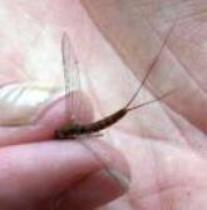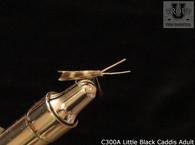
Most serious anglers are aware of fly fishing using the imitations of the Quill Gordon aquatic insect. Fishing with the nymph and the emerger prior to the hatch and fishing with the duns can indeed be productive. However, fishing with the spinner imitation fly is not so well known. First, what is a spinner?
The Quill Gordon duns molt into spinners to ecome sexually mature. Then, after they mate in the air over the water the males fall dead. The females fly back to ripen the eggs and return to deposit them over the water and then they too die.The spinners are very different in appearance than the duns. The Quill Gordon spinners can be recognized by the long tails and long front legs with the male having the longest legs and tails. Spinners congregate and mate high above the fast water of ripples and runs. You may not notice them unless you are looking up towards the sky. The males fall spent first and are joined by the females after their eggs have ripened and have been deposited in the water. Not all the males will fall in the water. Many will fall on the banks but most of the females will fall on the water.
At any one location, a Quill Gordon hatch last from about 45 minutes on bright clear days, to about an hour and a half on cloudy days. The spinner falls, meaning both the male spinner fall and the female spinner fall, each occur in about 30 minutes. Sometimes, they almost overlap. The spinners only stay on the surface of the water for a short time after they fall. Many of the males (which fall first) land on the banks but most of the females land on the water.
Unless the Quill Gordon spinner fall occurs very, very late in the day, or after fishing hours, you can usually catch just as many trout during the Quill Gordon spinner fall as you can during the hatch. However this is usually late in the day when most of the anglers have given up and gone home.You can learn more about the Quill Gordon spinners at the Perfect Fly store on Trout University.





